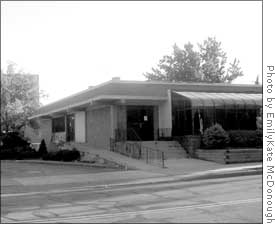
| << Front page | News | September 23, 2005 |
College St. project continues
 |
||
| A sustainable action: The RAX diner awaits its environmentally friendly destruction. | ||
As soon as the end of this week, the buildings around the RAX diner on East College street will begin this transformation into a long-anticipated, ecologically-friendly hot spot for the entire Oberlin community.
The Sustainable Community Associates started the East College Street Project in 2001, a development venture that aims at providing an environmentally sustainable building for apartments and commercial use. Of late, progress appeared to be slow around the construction site, but behind the scenes, the gears were turning.
Until recently, the efforts of SCA’s three Oberlin alumni — Josh Rosen, OC ’00, Ben Enzinga, OC ’00, and Naomi Sabel, OC ’01 — have been consumed by financial difficulties. Before they could move forward with the project, plans for funding needed solidification.
The SCA had acquired various subsidies, but more money was needed. The Oberlin City Council approved the ECSP for tax increment funding of $1.6 million over the summer. This was the final piece of the financial puzzle for SCA; now construction is set to begin.
Before the new structure can go up, however, the old structures must come down. Deconstruction of 43 East College Street will begin at the end of this week.
In line with its sustainability goals, SCA has commissioned deconstruction rather than demolition, the process that is usually used to tear down buildings. Deconstruction of the RAX, which will begin in a couple of months involves taking apart the old building and recycling or reusing approximately 75 percent of the used building materials.
SCA hopes to break ground in April 2006, with a goal for completion in spring of 2007.
At the moment, SCA is collaborating with architects and engineers to design the ecologically friendly structure.
“The most basic design plans include using natural, passive methods of conserving energy,” Sabel explained. “Active methods, such as geothermal heating and cooling, will be utilized as the performance of the building necessitates.”
Natural ventilation systems in the plan include operable windows and hallway/stairwell design that allows air from the roof to reach the second floor and circulate around the building.
In addition to providing alternative housing/commercial space, Rosen described the new building as “a laboratory” to analyze the effect that the awareness of sustainable measures will have on people who will live in the building. Daisy Allen, a College senior, is an example of a community member to be influenced by SCA’s unique undertaking.
She will study how monitoring systems affect the behavior of the new residents of East College Street. She plans to do this through an honors project, designing a building-use feedback system for residents to help them develop an understanding of their green building.
“My central concern is that I tailor to this community’s specific needs, because I want people to use and enjoy my design,” Allen said. “I hope that by fostering a greater awareness of this building and the way it works, I will help stimulate a sense of community pride in the SCA development.”
Community development lies at the heart of the ECSP. One of the SCA’s main goals in starting the project was to revitalize the local economy and the Downtown Oberlin area.
“We want to attract family businesses to the new development that provide goods that were formerly unattainable in the town of Oberlin,” said Rosen. “We want to keep the money of the townspeople in the town.”
SCA expects that small and family-run businesses in the Cleveland area will want to expand and come to Oberlin. Rosen, in fact, promised that SCA would consistently support small and local businesses.
“We are not even considering talking to chains,” he said.
Businesses that SCA hopes to bring into town include an Indian restaurant,
another coffee shop, an organic market and a bike shop. The services and goods
provided by these shops add variety to what Oberlin already has to offer and
will supplement what the small town cannot provide at the moment.
About us
Subscriptions
Advertising